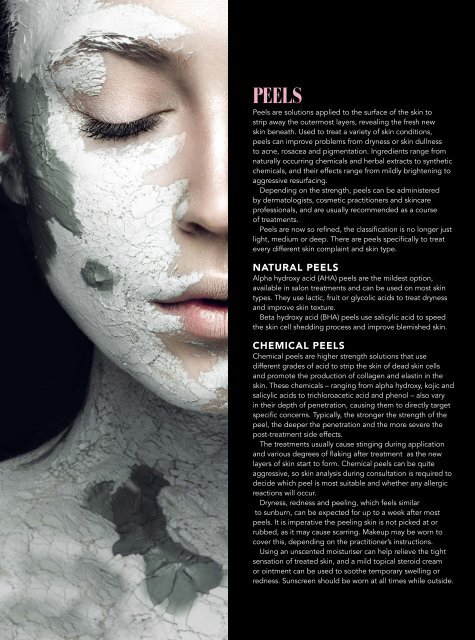CosBeauty Magazine #90
CosBeauty is the #BeautyAddict's guide to lifestyle, health and beauty in Australia and New Zealand. In this issue: - Summer Body; Meet this season's glow getters - 80+ Products to up your skincare game - 2020 Beauty lovers Christmas gift guide - Face-to-Face; the non-surgical tweakments turning heads
CosBeauty is the #BeautyAddict's guide to lifestyle, health and beauty in Australia and New Zealand.
In this issue:
- Summer Body; Meet this season's glow getters
- 80+ Products to up your skincare game
- 2020 Beauty lovers Christmas gift guide
- Face-to-Face; the non-surgical tweakments turning heads
You also want an ePaper? Increase the reach of your titles
YUMPU automatically turns print PDFs into web optimized ePapers that Google loves.
PEELS<br />
Peels are solutions applied to the surface of the skin to<br />
strip away the outermost layers, revealing the fresh new<br />
skin beneath. Used to treat a variety of skin conditions,<br />
peels can improve problems from dryness or skin dullness<br />
to acne, rosacea and pigmentation. Ingredients range from<br />
naturally occurring chemicals and herbal extracts to synthetic<br />
chemicals, and their effects range from mildly brightening to<br />
aggressive resurfacing.<br />
Depending on the strength, peels can be administered<br />
by dermatologists, cosmetic practitioners and skincare<br />
professionals, and are usually recommended as a course<br />
of treatments.<br />
Peels are now so refined, the classification is no longer just<br />
light, medium or deep. There are peels specifically to treat<br />
every different skin complaint and skin type.<br />
NATURAL PEELS<br />
Alpha hydroxy acid (AHA) peels are the mildest option,<br />
available in salon treatments and can be used on most skin<br />
types. They use lactic, fruit or glycolic acids to treat dryness<br />
and improve skin texture.<br />
Beta hydroxy acid (BHA) peels use salicylic acid to speed<br />
the skin cell shedding process and improve blemished skin.<br />
CHEMICAL PEELS<br />
Chemical peels are higher strength solutions that use<br />
different grades of acid to strip the skin of dead skin cells<br />
and promote the production of collagen and elastin in the<br />
skin. These chemicals – ranging from alpha hydroxy, kojic and<br />
salicylic acids to trichloroacetic acid and phenol – also vary<br />
in their depth of penetration, causing them to directly target<br />
specific concerns. Typically, the stronger the strength of the<br />
peel, the deeper the penetration and the more severe the<br />
post-treatment side effects.<br />
The treatments usually cause stinging during application<br />
and various degrees of flaking after treatment as the new<br />
layers of skin start to form. Chemical peels can be quite<br />
aggressive, so skin analysis during consultation is required to<br />
decide which peel is most suitable and whether any allergic<br />
reactions will occur.<br />
Dryness, redness and peeling, which feels similar<br />
to sunburn, can be expected for up to a week after most<br />
peels. It is imperative the peeling skin is not picked at or<br />
rubbed, as it may cause scarring. Makeup may be worn to<br />
cover this, depending on the practitioner’s instructions.<br />
Using an unscented moisturiser can help relieve the tight<br />
sensation of treated skin, and a mild topical steroid cream<br />
or ointment can be used to soothe temporary swelling or<br />
redness. Sunscreen should be worn at all times while outside.<br />
www.cosbeauty.com.au 95

















